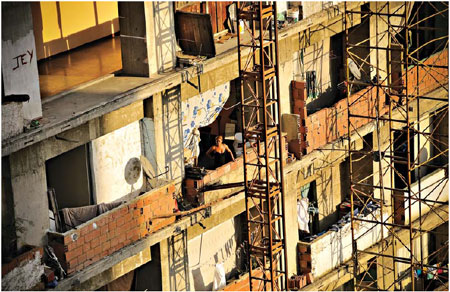Society
Skyscraper is home for the desperate
Updated: 2011-03-13 07:57
By Simon Romero and Maria Eugenia Diaz (New York Times)
|
An unfinished tower is one of many buildings occupied by squatters in Caracas. "Society hates us," says one. Meridith Kohut for The New York Times |
 |
CARACAS, Venezuela - Architects still call the 45-story skyscraper the Tower of David, after David Brillembourg, the brash financier who built it in the 1990s. The helicopter landing pad on its roof remains intact, a reminder of the airborne limousines that were once supposed to drop bankers off for work.
The office tower, one of Latin America's tallest skyscrapers, was meant to be an emblem of Venezuela's entrepreneurial mettle. But that era is gone. Now, with more than 2,500 squatters making it their home, the building symbolizes something else entirely in this city's center.
The squatters live in the uncompleted high-rise, which lacks several basic amenities like an elevator. The smell of untreated sewage permeates the corridors.
The skyscraper, surrounded by billboards and murals proclaiming the advance of President Hugo Chavez's "Bolivarian revolution," is a symbol of the financial crisis that struck the country in the 1990s, the expanded state control over the economy that came after Mr. Chavez took office in 1999 and the housing shortage that has worsened since then, leading to widespread squatter takeovers in this city.
Few of the building's terraces have guardrails, yet dozens of DirecTV satellite dishes dot the balconies. The tower commands some of the most stunning views of Caracas.
"I never let my child out of my sight," said Yeaida Sosa, 29, who lives with her 1-year-old daughter, Dahasi, on the seventh floor overlooking a bustling artery, Avenida Andres Bello. Ms. Sosa said residents were horrified after a young girl recently fell to her death from a high floor.
"God decides when we enter his kingdom," said Enrique Zambrano, 22, an electrician who lives on the 19th floor. Mr. Zambrano, like many of the other squatters in the skyscraper, says he is an evangelical Christian. Their pastor is Alexander Daza, 33, a former gang member who found religion in prison. Mr. Daza, commonly known as El Nino, or The Kid, led the occupation of the Tower of David in October 2007.
Back then, the building had already been vacant for more than a decade. Its developer, Mr. Brillembourg, a dashing horse breeder, died of cancer at age 56 in 1993, leaving behind hobbled companies. The government absorbed their assets, including the unfinished skyscraper, during a 1994 banking crisis.
Once one of Latin America's most developed cities, Caracas now grapples with an acute housing shortage of about 400,000 units, breeding building invasions. In the area around the Tower of David, squatters have occupied 20 other properties, including the Viasa and Radio Continente towers. White elephants around the city, like the Sambil shopping mall close to the Tower of David and seized by the government, now house flood victims.
Private construction of housing here has virtually ground to a halt because of fears of government expropriation. The government, hobbled by inefficiency, has built little housing of its own for the poor. On occasion, Mr. Chavez has called for squatters to be dislodged. But in January, he urged the poor to occupy unused land in affluent parts of Caracas.
Tower of David squatters, who live on 28 stories and plan to go higher, have created a semblance of order within the skyscraper. Sentries with walkie-talkies guard entrances. Each inhabited floor has electricity, jury-rigged to the grid, and water is transported up from the ground floor. Residents chafe at being called "invaders," the term here for squatters, preferring the less contentious word "neighbor."
Almost every floor has a small bodega. Some residents own cars parked in the building's garage. Others sanguinely point to their trim physiques, a result of going up and down the stairs each day.
Jose Hernandez, 30, sleeps with his wife and daughter in one bed under mosquito netting, protection from dengue fever. In his apartment, once meant to be a banker's corner office, he showed the view, which included a mosque's minaret and, in the distance, Petare, the patchwork of hillside slums where he grew up. Now Mr. Hernandez dons a tie and jacket each day and goes to work at, of all places, a bank.
"They call me an invader and I work in the credit department of Banco de Venezuela," said Mr. Hernandez, referring to the state-owned institution that he says employs him. "Society hates us, and the government doesn't know what to do with us. Do they really think we want to be living in the Tower of David?"
The New York Times
E-paper

Factory fever
Despite auto manufacturing bubble scare, car giants gear up expansion of factories.
Dressed for success
Fabric of change
High spirits
Specials

Earthquake Hits Japan
A massive 8.8 magnitude quake hit the northeast coast of Japan on March 11,2011.

NPC & CPPCC sessions
Lawmakers and political advisers gather in Beijing to discuss major issues.

Panda campaign
Black-and-white bear helps Chengdu in marketing campaign after quake.

